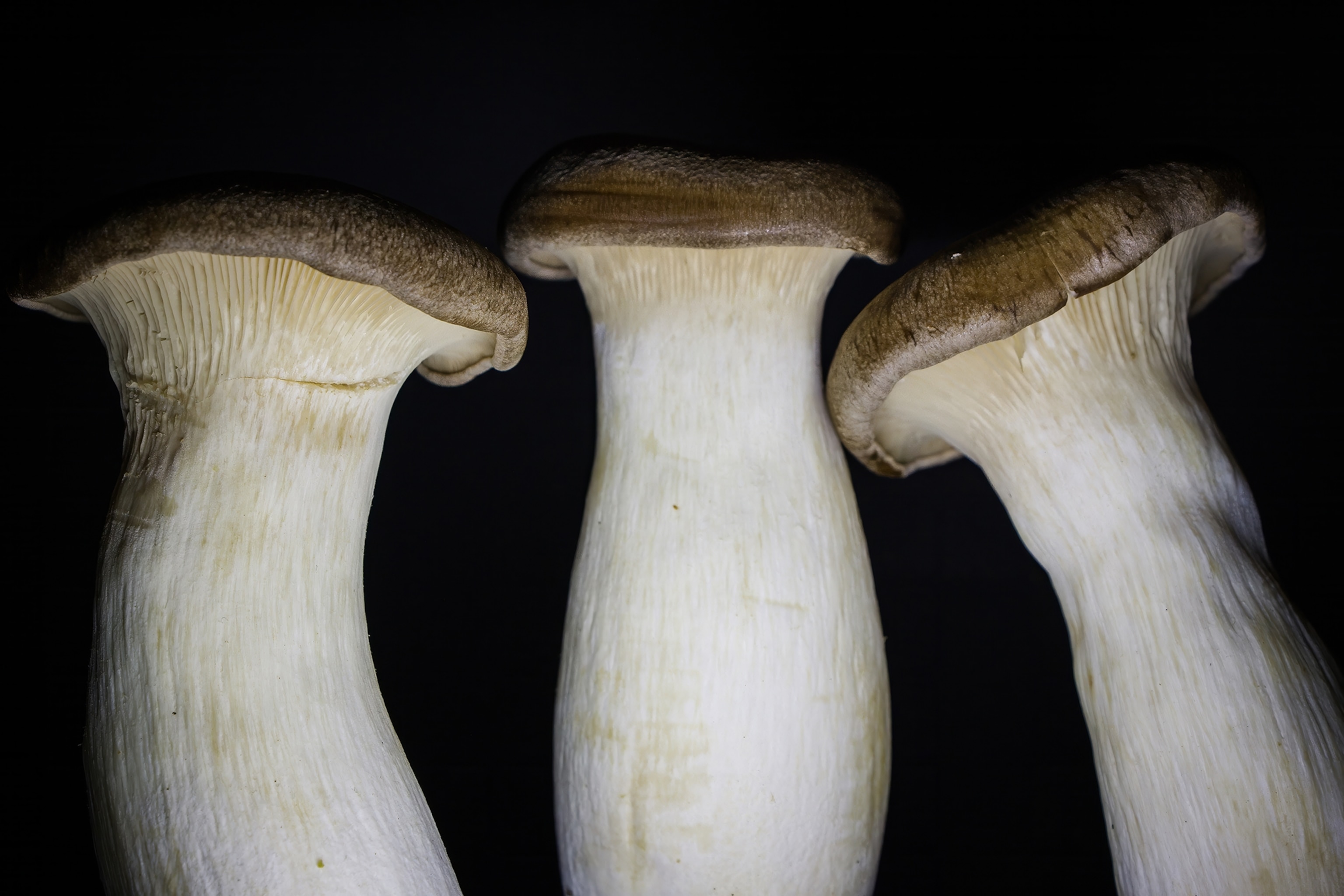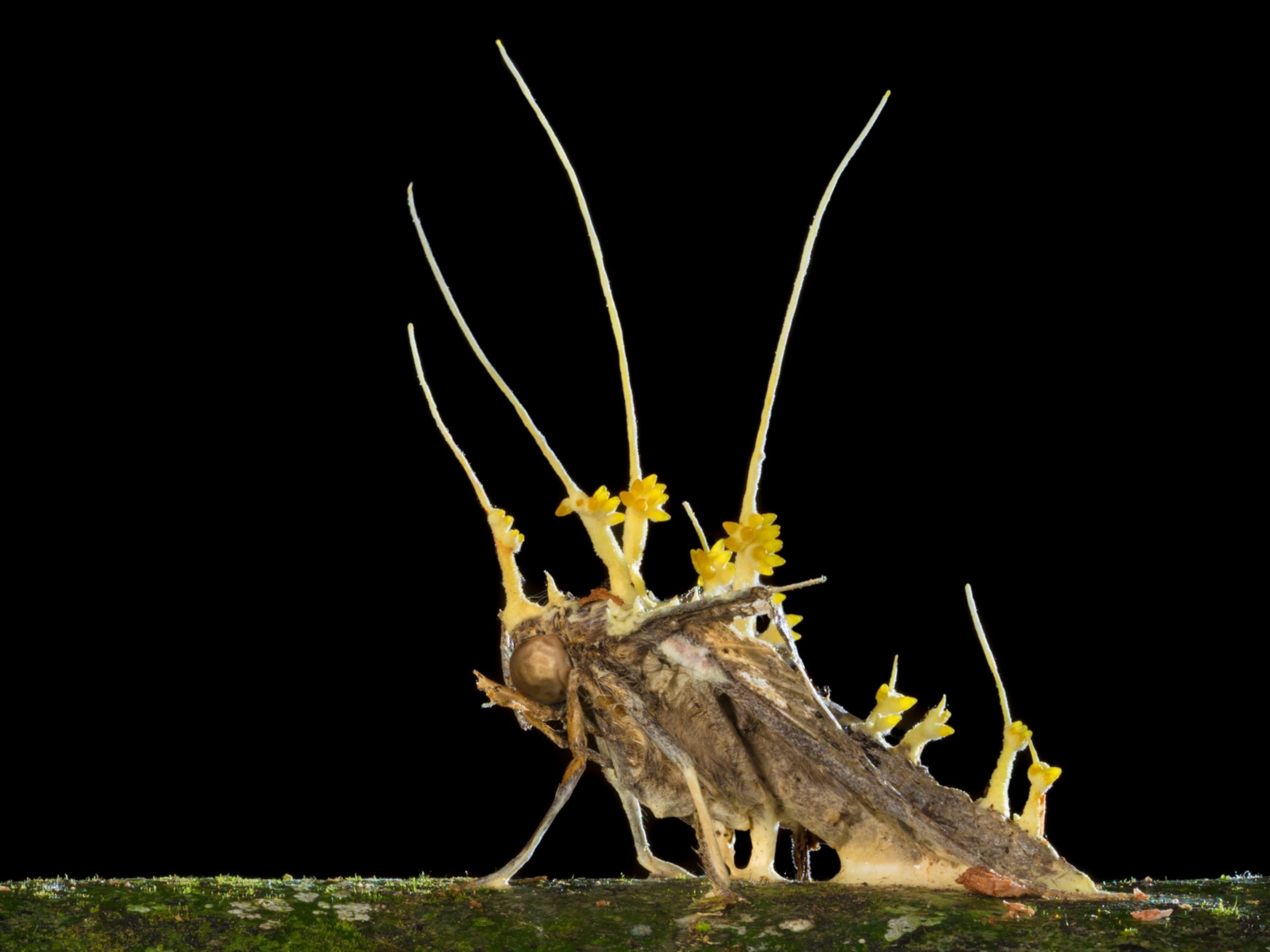Watch this fungus control a robot
“Biohybrid robots” that are part fungi and part computer convert fungal electrical signals into digital commands, a promising advance in building more sustainable robots.

A starfish-like robot contracts its five legs to inch across a wood floor, not powered by batteries or plugged into an outlet, but instead controlled by signals from mushrooms.
The new robot, along with another wheeled robot controlled by fungi, was developed by Cornell University researchers to create robots inspired by and integrated with nature.
So called “biohybrid robotics” is a relatively new field that combines plant, animal, and fungal cells with synthetic materials to create robots. Tiny biohybrid robots made from mouse neurons can walk and swim, swimming robots for ocean exploration have been created using jellyfish cells, and a walking and pivoting robot was made from rat muscle cells.
But using animal cells in biorobots is expensive and ethically complicated, while plant cells tend to respond more slowly to stimuli. Now, a new study published in Science Robotics outlines how fungi might be a key piece of the biohybrid puzzle.
How does it work?
The researchers started by cultivating mycelia—the network of strands that connect mushrooms underground and allows them to communicate—from king oyster mushrooms.
King oyster mushrooms are easy to grow and maintain, making them ideal for use in robots. The researchers cultivated the fungi and guided its mycelia to grow onto a 3D-printed scaffold full of electrodes.
Interconnected mycelia give off electrical impulses in response to changes in the environment, like the impulses the neurons in our brains give off to communicate with each other. Because the mycelial network was connected to electrodes, its electrical impulses could communicate with a computer interface. The computer then converts those electrical impulses into digital commands, which are sent to the robots’ valves and motors, telling them to do things like move forward. The computer conversion of electrical impulses to commands was inspired by how animal neurons work, converting our brains’ electrical impulses into motor functions like moving limbs.
The fungi-computer interface enables communication between the mycelia and the robot, so when the researchers shine light on the mycelia, they respond with electrical impulses that make the robots move.
“Mushrooms don’t like light, they grow in dark areas,” says Robert Shepherd, engineer at Cornell University and one of the study’s authors, “since they really don’t like light, that provided a strong signal.” By shining more ultraviolet light on the fungi-computer interface, the fungi’s electrical signals in response became stronger, making the robots move faster.
How will these biohybrid robots be used?
The new technology could be used in agriculture: fungi are extremely sensitive to their environment, and robots like these could detect chemical contaminants, poisons, or pathogens in crop fields better than synthetic robots.
Fungi can handle extreme conditions, according to Anand Mishra, engineer at Cornell University and another author of the study. Fungal cells can survive in very salty water or severe cold, which might make fungi biohybrid robots better than animal or plant biohybrid robots in extreme environments. Mushrooms can also survive radiation better than many other organisms, so they could help detect radiation at hazardous sites.
The new research is an exciting advancement in biohybrid robotics, says Vickie Webster-Wood, engineer at Carnegie Mellon University, who was not involved in the study. One major benefit of biohybrid robots is their sustainability. “If you’re trying to build a swarm of robots to go monitor a coral reef, and you build them out of electronics with heavy metals and plastics, and you’re not able to collect them all, that’s a lot of waste that’s been introduced into the environment,” says Webster-Wood.
Building with biology enables engineers to use materials native to the environment the robot will be in. A biohybrid robot made from plant cells can help with reforestation, for example, or a medical robot built from a person’s cells could be used inside their body. At the end of these robots missions, less cleanup is needed, and the risk of harmful pollutants left behind is lower.
Fungi are everywhere, and creating these types of robots could be more feasible in areas with fewer resources, says Webster-Wood. “That means you could potentially send a very small [amount] of mycelium to a very remote destination where you then grow up the mycelium and can build robots there—so there could be applications in space robotics.”
The accessibility and endurance of these new fungi-controlled robots are also promising for longer-term uses. “The conditions to keep the mycelium alive seem to be easier to achieve in a robot than the systems we need to keep mouse muscle alive, for example,” says Webster-Wood, “so there’s some potential there to do longer-mission environmental work.”
Related Topics
You May Also Like
Go Further
Animals
- What would the world look like without mosquitoes?What would the world look like without mosquitoes?
- Social media loves to villainize dolphins. Here's why it's wrong.Social media loves to villainize dolphins. Here's why it's wrong.
- How did wolves evolve into dogs? New fossils provide cluesHow did wolves evolve into dogs? New fossils provide clues
- This unorthodox method is saving baby parrots from extinctionThis unorthodox method is saving baby parrots from extinction
- A deadly disease that affects cats big and small found in U.S.A deadly disease that affects cats big and small found in U.S.
Environment
- ‘Corn sweat’—and other weird weather phenomena—explained‘Corn sweat’—and other weird weather phenomena—explained
- A sea tornado sank a yacht. We might see them more often.A sea tornado sank a yacht. We might see them more often.
- How billions of dollars are revolutionizing ocean explorationHow billions of dollars are revolutionizing ocean exploration
- Where to go stargazing in Chile according to a local astronomer
- Paid Content
Where to go stargazing in Chile according to a local astronomer
History & Culture
- Did Babe Ruth really ‘call’ this legendary home run?Did Babe Ruth really ‘call’ this legendary home run?
- The real history behind the legend of China's Monkey KingThe real history behind the legend of China's Monkey King
- How new technology transformed the American workforceHow new technology transformed the American workforce
- This secret Civil War sabotage mission was doomed from the startThis secret Civil War sabotage mission was doomed from the start
- This rare burial site reveals secrets about the Sahara's lush pastThis rare burial site reveals secrets about the Sahara's lush past
Science
- Why some say tennis is 'the world's healthiest sport'Why some say tennis is 'the world's healthiest sport'
- Your body ages rapidly at 44 and 60. Here's how to prepare.Your body ages rapidly at 44 and 60. Here's how to prepare.
- How do gold nuggets form? Earthquakes may be the keyHow do gold nuggets form? Earthquakes may be the key
- Astronauts getting stuck in space is more common than you thinkAstronauts getting stuck in space is more common than you think
Travel
- These are the must-see sights of Italy's Veneto regionThese are the must-see sights of Italy's Veneto region
- A guide to St John's, Atlantic Canada's iceberg capitalA guide to St John's, Atlantic Canada's iceberg capital




